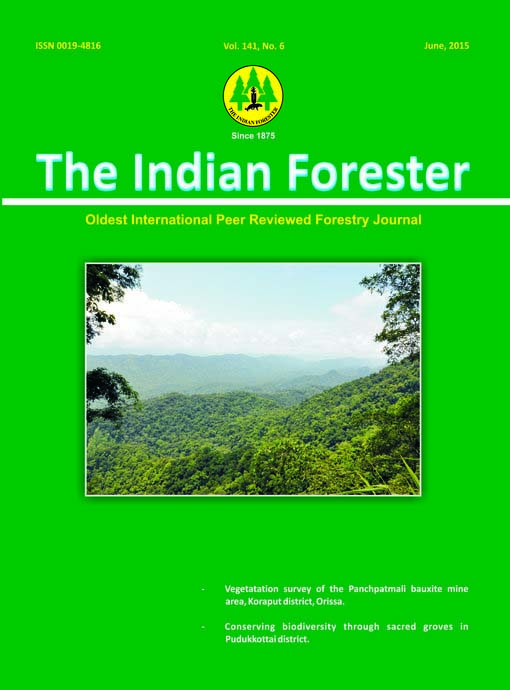Growth and Carbon Storage Study in some Multipurpose Tree Species of Pondicherry Area
DOI:
https://doi.org/10.36808/if/2015/v141i6/71316Keywords:
Biomass, Growth, Carbon storage, Multipurpose trees.Abstract
Growth rate and carbon storage in selected multipurpose trees were assessed to identify the fast growing trees and also those that store high carbon in their biomass. Among the plant parts studied, wood stored the higher carbon (56.38 mg/g), leaf stored the minimum (53.27 mg/g) and bark had a medium storage (54.06 mg/g). The fast growing tree with maximum increase in diameter and with maximum biomass production was Syzigium cumini (4.42 cm) and slow growing tree was Milletia pinnata (0.82 cm). Syzigium cumini stored maximum carbon (2.71 Kg/year) and biomass (4.9 Kg/year). Milletia pinnata stored the minimum carbon (0.67 Kg/year) and biomass (1.24 Kg/year). Parkia biglandulosa (3.97 cm), Khaya senegalensis (3.7 cm), Tabebuia rosea (3.5 cm), Peltaphorum pterocarpum (3.17 cm) are also considered as fast growing trees. Trees with fast growth rate and also those which store high biomass carbon are recommended for planting as avenue and ornamental trees as a step to mitigate atmospheric carbon concentration.References
Chavan B.L., Rasal G.B. (2010). Sequestered standing carbon stock in selective tree species grown in University campus at Aurangabad, Maharashtra, India. International Journal of Engineering Science and Technology, 2: 3003 – 3007.
Chave J., Andalo C., Brown S., Cairns M.A., Chambers J.Q., Eamus D., Folster H., Fromard F., Higuchi N., Kira T., Lescure J.P., Nelson B.W., Ogawa H., Puig H., Riera B. and Yamakura T. (2005). Tree allometry and improved estimation of carbon stocks and balance in tropical forests. Oecologia, 145: 87 – 99.
Chauhan S.K., Gupta N., Ritu S., Yadav and Chauhan R. (2009). Biomass and carbon allocation in different parts of agroforestry tree species. Indian Forester, 135: 981 - 993.
Dinakaran J., Krishnayya N.S.R. (2010). Variations in soil organic carbon and litter decomposition across different tropical vegetal covers. Current Science, 99: 1051 - 1060.
Evans J.R., Caemmerer S.V. (1996). Carbon Dioxide Diffusion inside Leaves. Plant Physiology, 110: 339-346.
Friend A.L., Coleman M.D., Bebrands J.G. (1994). Carbon allocation to root and shoot systems of woody plants. Biology of Adventitious Root, 245 – 273
Johnson A.D., Gerhold H.D. (2001). Carbon storage by utility-compatible trees. Journal of Arboriculture, 27: 57 – 68.
Korner C. (2003). Carbon limitation in trees. Journal of Ecology, 91: 4–17.
McPherson E.G. (1998). Atmospheric carbon dioxide reduction by Sacramento’s urban forest. Journal of Arboriculture, 24: 215 – 223.
Negi J.D.S., Manhas R.K. and Chauhan P.S. (2003). Carbon allocation in different components of some tree species of India: A new approach for carbon estimation. Current Science, 85: 1528 – 1531.
Nowak D.J, Greenfield E.J, Hoehn R.E. and Lapoint E. (2013).Carbon storage and sequestration by trees in urban and community areas of the United States. Environmental Pollution, 178: 229 – 236.
Zhe W., Xuan C., Shan Y., Guang Rong S., Yu Jie H. and Chun Jiang L. (2013). Characteristics of carbon storage in Shanghai’s urban forest. Chinese science bulletin, 58: 1130 – 1138.
Downloads
Downloads
Published
How to Cite
Issue
Section
License
Unless otherwise stated, copyright or similar rights in all materials presented on the site, including graphical images, are owned by Indian Forester.





